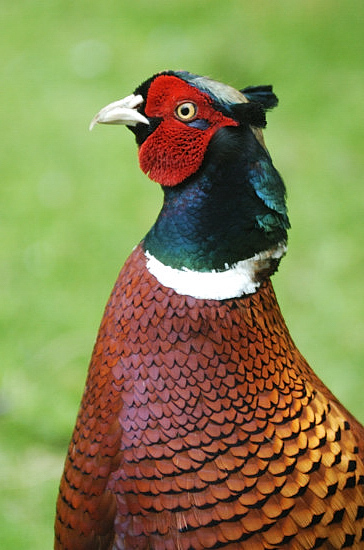Article
Common Pheasant
Latin Name: Phasianus colchicus
A large, long tailed game bird, seen across the
majority of the UK, except the far north and west of Scotland, in open
countryside near woodland edges, copses and hedgerows. They are in fact native
to Asia and were introduced to the UK long ago for breeding as a game bird to
satisfy those who like to shoot them for sport. As well as being wild it is the
most popular breed for game farms and for this reason is one of the world's most
hunted birds. The male comes in many colours although the most common seen the
UK is the colourful Ring-Necked Pheasant, a collective name for a subspecies and
their cross breeds. They were first
introduced into Britain in the 10th century, but became locally extinct in the
early 17th century. It was rediscovered as a game bird in the 1830's and since
has been extensively reared by gamekeepers. They are bred to be hunted in
Europe, and especially the UK. A hunt takes the form of paying guns waiting for
the birds to be driven over them by beaters. The open season in the UK is
October-February, under the Game Act 1831. It was a popular royal pastime in
Britain to shoot Common Pheasants. King George V shot over a thousand pheasants
out of a total bag of 3937 over a six day period in December 1913, a total which
still stands as the British record. Farmed birds are also supplied to
restaurants and butchers for human consumption and it is estimated that UK farms
have some 35 million birds. |

 |
You will see
them in the countryside in fields, sat on hedges, on the side of roads and
sometimes in gardens if food is in plentiful supply. As well as being shot their
other form of death is be road kill, being hit by something on the roads either
when crossing on foot, or when flying over hedgerows.
Identification
Males: Are very colourful
with a chestnut brown body and golden-brown iridescent markings on body and
tail. They have a green head and neck, although the throat and cheeks are
glossed purple and they have a white band at the base of the neck, small ear
tufts, and a red face and wattle. Females: are buff coloured with darker mottled
markings. Juvenile males have the appearance of the female until about 10 weeks
after hatching when they begin to grow their bright feathers on breast, head and
back.
|
Animal
Facts
In Britain: All Year Round
Life Span: It is thought they do not
survive longer than a year, maximum recorded age is 2 years and 1 month.
Statistics: Male 75-90cm long, long tail accounting for 50cm of overall
length. Wingspan 80-90cm. Female 53-63cm with 20cm tail. Weight 900-1500kg
Habitat: In natural habitat lives in
grassland near water with small copses of trees. In the UK they tend to favour
Open countryside near woodland, copses and hedgerows.
Food: Seeds, grain, shoots, fruit, grass,
insects, and a wide range of invertebrates like worms, small snakes, lizards
etc.
Breeding: There are said to be 1.8-1.9
million breeding females in the UK. They nest on the ground under a hedge or
amongst tall grass, producing a clutch of around 10 eggs over a 2-3 week period
from April-June. Incubation is 23-26 days, they fledge 12-14 days. Chicks stay
near the hen for several weeks and start to resemble adults at 15 weeks.
|
Conservation
Status

Least Concern
 |
Distribution:
Most of the UK in open countryside near woodland,
copses and hedgerows. Least common in upland and urban areas and are not seen in
the far north and west of Scotland.
Behaviour: Females are social birds and outside the breeding season will
form loose flocks. Males tend to be solitary although have a harem of
females during the breeding season, which they defend from intruding males with
sometimes vicious fights. They are timid and nervous of humans particularly in
areas where they are hunted. They are short distance flyers, preferring to run
at speed, if startled they can take off upwards at speed, with a distinctive
'whirring' wing sound. Their cruising flight speed is around 27-38mph however if
being chased they can fly up to 60mph. They are ground feedings and spend a
large part of the day on the ground. At night they shelter/roost in trees.
Conservation Status: Around 30 million are released each year on shooting
estates, so there is no concern about numbers. However in the UK are they
protected by the Game Acts, giving them protection during the close/breeding
season.
See Also
Wikipedia Information

The World Pheasant
Association

BTO Bird Facts

|